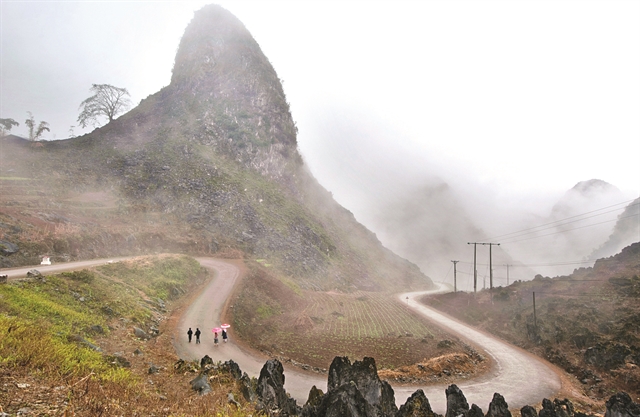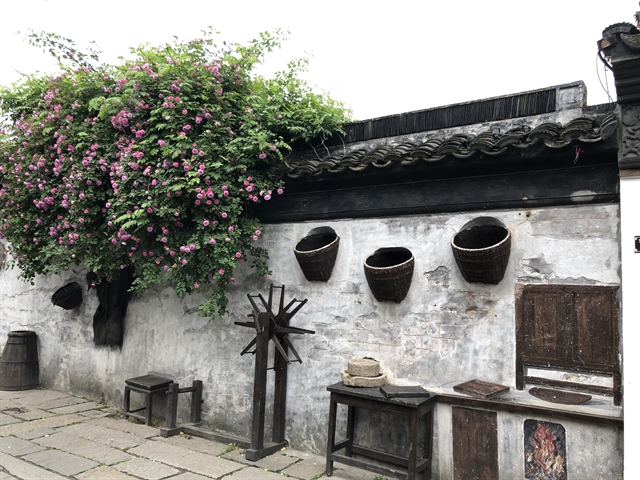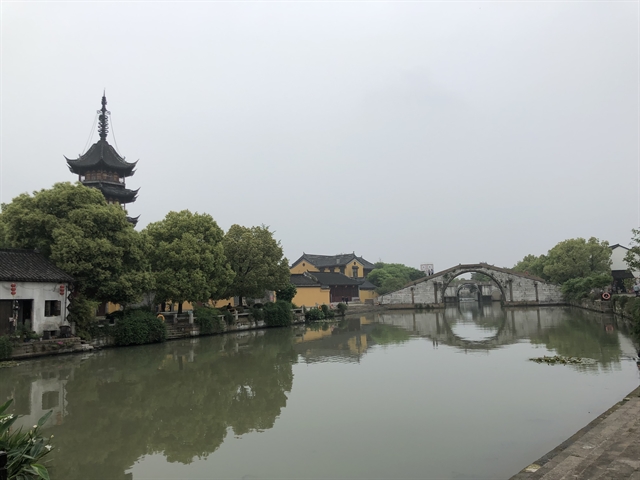 Sunday/Weekend
Sunday/Weekend


|
| A street corner with ancient silk weaving tools on display. |
By Lê Hương
There is a Chinese saying literally translated as “Above there is heaven, down here there are Su and Hang", praising the legendary beauty of the two cities.
The old saying has been proved right time and time again throughout history as the beauty of northeastern China's Suzhou and Hangzhou continue to lure tourists from all over the world.
Zhenze town, located in Suzhou's Wujang District, lies between the cities of Suzhou and Hangzhou.
The town is home to significant waterfront architecture and has built a reputation for its fish, rice and silk over the past 1,200 years.
Zhenze was the birthplace of Suzhou’s silk industry around a thousand years ago when villagers first took up the career of raising silkworms and weaving silk.
The town was first mentioned in an official document during the Spring and Autumn Period (770-256 BC). Yet not until the Song Dynasty (1127-1279) was the town officially established under its current name.
The local silk industry flourished and became famous nationwide, reaching its peak under the Ming and Quing dynasties, when the town produced some 33 per cent of the silk products in China.
Throughout its long history, the town has never lost its fame as one of the country's leading silk towns.

|
| A silk seller (left) introduces a tourist to the process of making silk from worms at a showroom of a local silk company. VNS Photos Lê Hương |
In 2016, Zhenze was honoured along with the first batch of specialised small towns in China for its flourishing silk-related agriculture, industry and tourism. In 2017, the town was again awarded with the first batch of provincial-level tourism towns and rural villages.
Today, visitors to the town can see the mulberry fields, pick mulberry leaves and feed silkworms, try local snacks and experience folk customs.
Here and there in the streets, one can still see old silk-weaving tools like those used in ancient times such as rustic wooden wheels for collecting silk threads.

|
| A view of Zhenze waterway and old buildings along its shore. |
Attractions include distinctive Su-style buildings, bridges, temples and gardens such as Ciyun Temple Tower, built during the Three Kingdoms Period (AD 220-280). Tourists may also enjoy Shijian Hall, a private garden built in the 19th century by a wealthy local family, and Yuji Bridge, built in 1715 in commemoration of legendary Chinese ruler Yu the Great.
“We have a total of 35sq.km of old houses and the old quarter covers 0.996sq.km,” Xiao Ying Wu, the manager of a local tourism company, told Việt Nam News. “We love the area as it’s a part of our history.”
Xiao said that every year, the authorities invite groups of conservation specialists from universities all over the country to discuss methods for preserving the town.
Every month, there is a training programme for locals on how to maintain the old quarter.
“We are very proud of the buildings and will devote ourselves to protecting the old houses,” said Xia Lindi, a 60-something woman residing in the town.
As many as 12,000 people are still living in the town, which last year received 560,000 tourists.
Yu Ji Bridge
A significant structure leading to the town is Yu Ji stone bridge, which was built in 1715 in commemoration of Yu the Great's introduction of flood control methods.
History books mention that in 1780, Emperor Qian Long (1711-1799) made his fifth tour south, passing the bridge.
Shijian Hall
Walking along Pagoda Street, tourists will find a part of a mansion that now serves as a museum displaying a typical residential and commercial house of a rich local family in the 19th century.
First built in 1884 by Xu Rufu, the house faces south and is surrounded by water in three directions: The Ditang River is to the south, the Xieqiao River is to the west and the Lotus River is to the north.
The house is categorised as a key national relic site and it is a fine example of the style typical of big houses in the region south of the Yangtze River.
According to an information leaflet, the original house covers an area of 2,500sq.m with a total of 147 rooms. It includes river docks, shops, streets, halls, inner chambers, gardens and servants’ quarters. The old structure is permeated with traditional Chinese style.
“Houses are built on the street while in the houses there are streets, creating a dignified yet simple traditional Chinese style, with official, Confucian and commercial functions,” the leaflet reads.
“I’m amazed at the rock garden at one end of the mansion,” said Muhammad Kakar, a tourist from Pakistan. “The rocks and trees are mingling with one another. I can imagine how rich the family was in the past. What a leisurely and airy mansion!” -- VNS




